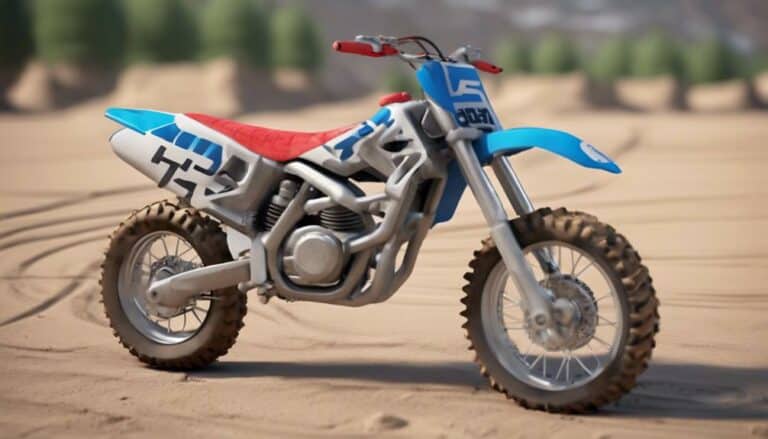You might think that tire pressure for dirt bike tires is a one-size-fits-all affair, but it's far more nuanced than that. The right tire pressure can make a significant difference in how your bike performs on different terrains.
So, how do you determine the ideal tire pressure for your dirt bike? Let's uncover the secrets to maximizing your ride by finding that sweet spot that will have you cruising with confidence and control.
Key Takeaways
- Terrain type and rider weight dictate ideal tire pressure.
- Proper pressure enhances traction, stability, and ride comfort.
- Regularly monitor and adjust tire pressure for optimal performance.
- Adjust pressure based on terrain to maximize traction and prevent punctures.
Factors Influencing Dirt Bike Tire Pressure
When determining the recommended tire pressure for your dirt bike, several key factors come into play. Tire pressure isn't a one-size-fits-all measurement; it varies depending on terrain type, rider weight, tube thickness, and even the tire's construction.
The terrain type you ride on greatly influences the ideal tire pressure. For softer terrains like mud or sand, lower tire pressures provide better traction by increasing the tire's footprint. Conversely, on hard-packed surfaces, higher tire pressures are preferred for improved handling and reduced rolling resistance.
Rider weight is another important factor to take into account. Heavier riders necessitate higher tire pressures to prevent pinch flats and maintain proper tire shape. Additionally, the thickness of your inner tubes impacts the required tire pressure. Thicker tubes can withstand higher pressures, allowing for increased firmness and support.
Advantages of Proper Tire Pressure
Maintaining the recommended tire pressure for your dirt bike yields numerous advantages that directly impact your riding experience and performance. Proper tire pressure plays a critical role in enhancing traction and grip on various terrains, resulting in better handling and control of your bike.
By ensuring the best tire pressure, you greatly reduce the risk of experiencing pinch flats and other tire-related issues, hence preserving the integrity of your tires and enhancing their longevity.
Additionally, best tire pressure contributes to better stability, improved cornering performance, and increased ride comfort during your off-road adventures. Adjusting your tire pressure according to factors like rider weight and terrain type can maximize your bike's performance potential, allowing you to enjoy a smoother and more efficient ride.
Maintaining the right tire pressure is key to releasing the full capabilities of your dirt bike while ensuring a safer and more enjoyable riding experience.
Monitoring Tire Pressure for Optimal Performance
Regularly monitoring your dirt bike's tire pressure is essential for maintaining peak performance on various terrains and riding conditions. Both the front and rear tire pressures play an important role in how your bike handles and grips the ground.
To guarantee accuracy, use a tire pressure gauge that measures in quarter-pound increments. Before each ride, check the tire pressure and make adjustments as needed based on the terrain you'll be riding on.
After your ride, check the pressure again to see if any changes occurred during your outing. Quick adjustments between rides can greatly improve your dirt bike's handling and traction, giving you more control and confidence while riding.
Preventing Tire Punctures on Dirt Bikes
To optimize your dirt bike's performance and reduce the risk of punctures, understanding how tire pressure affects puncture prevention is essential. When riding on dirt tracks, especially in rough terrains, preventing tire punctures becomes important. Here are some key tips to help you prevent tire punctures on your dirt bike:
- Choose the Right Tire Pressure: Maintaining the correct tire pressure for both the front and rear tires is important. Higher tire pressure can reduce the risk of punctures on rocky or jagged terrain.
- Inspect Your Tires Regularly: Check your tires for any signs of wear or damage before each ride. Removing debris embedded in the tread can help prevent punctures.
- Stop the Engine When Dealing with Punctures: If you suspect a puncture while riding, stop the engine immediately to prevent further damage to the tire. This can help avoid a complete blowout and make repairing the puncture easier.
Tips for Adjusting Dirt Bike Tire Pressure
When adjusting dirt bike tire pressure, consider the terrain you will be riding on and make precise adjustments for peak performance. It is essential to monitor and adjust tire pressure according to the specific conditions you will encounter. Starting with 12 psi for the front tire and 12.5-13 psi for the rear tire is a good baseline. For softer terrains like sandy tracks, lower the tire pressure to 11 psi for the front and 11.5 psi for the rear to increase traction. Conversely, for hardpack tracks, higher tire pressure of 13 psi for the front and 13.5 psi for the rear will provide better stability and control. Top motocross teams understand the importance of making precise tire pressure adjustments to optimize performance. Utilize a tire pressure gauge that measures in quarter-pound increments for accurate adjustments.
| Tire Pressure (psi) | Front | Rear |
|---|---|---|
| Soft (sand) | 11 | 11.5 |
| Hardpack | 13 | 13.5 |
Conclusion
In summary, maintaining the recommended tire pressure for dirt bike tires is vital for best performance and safety. By adjusting the pressure based on the terrain you'll be riding on, you can improve traction and overall handling.
Remember to check and adjust the tire pressure at your destination to guarantee a smooth and enjoyable ride. Keep your tires properly inflated to prevent punctures and enhance your dirt biking experience.
Ride on, ride safe!

